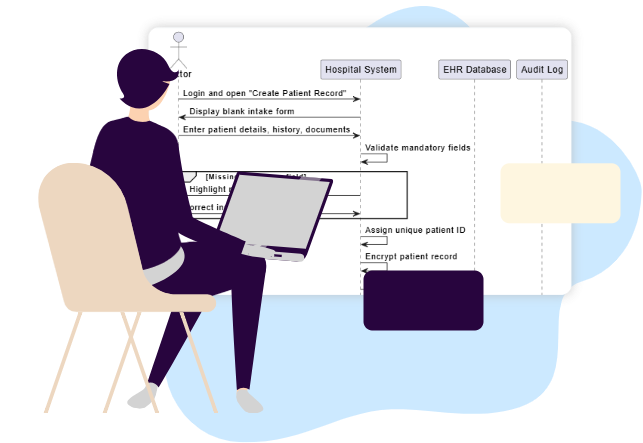Now Reading: Why Decomposition Important in Sequence Diagrams
-
01
Why Decomposition Important in Sequence Diagrams
Why Decomposition Important in Sequence Diagrams
Large systems often start with simple sequence diagrams that outline how an actor interacts with the system. While these diagrams are useful, they can quickly become overloaded and hard to interpret. Decomposition provides a solution by separating user interface components from the system’s business logic, making the design more structured and scalable.
What is Decomposition in Sequence Diagrams?
Decomposition is the process of identifying view objects and model objects within a system:
- View objects represent the screens, input fields, or UI elements that interact directly with the actor.
- Model objects handle the processing, validations, and updates that power the system behind the scenes.
This separation makes diagrams clearer and reflects the actual structure of a well-designed system.

Why Decomposition Important
Breaking down a sequence diagram into these two layers is crucial for several reasons:
- Clarity: Diagrams are easier to read and understand.
- Maintainability: User interface changes do not impact the system’s logic.
- Scalability: New features can be added by extending the appropriate layer.
- Accuracy: Reflects how modern architectures naturally divide responsibilities.
The Challenge of Manual Decomposition
For complex systems, manually identifying view and model objects can be time-consuming and error-prone. Designers may overlook hidden logic or mix responsibilities, leading to diagrams that are incomplete or misleading.
How AI Simplifies Decomposition
This is where the Sequence Diagram Refinement Tool makes a difference. With the Decompose Layer step, AI analyzes your initial diagram and automatically extracts relevant view and model objects. Instead of starting from scratch, you instantly see the system broken down into layers that reflect real-world architecture.
Example: An ATM “Withdraw Cash” diagram becomes decomposed into CardReader, PINInputField, and DisplayScreen as view objects, plus PINValidator, AccountDebitor, and CashDispenser as model objects.
Result: A cleaner, layered diagram that is ready for further detailing.
Conclusion
Decomposition is more than just a refinement step — it is the key to transforming a raw interaction flow into an architecture-ready design. With AI handling the heavy lifting, you can focus on improving the system’s structure, scalability, and clarity, while ensuring your sequence diagrams remain an effective communication tool.

